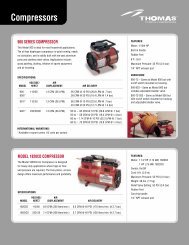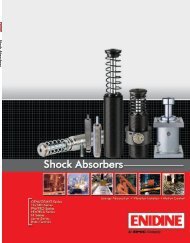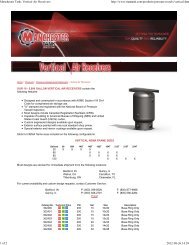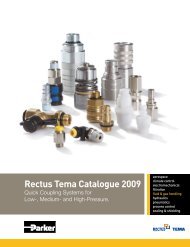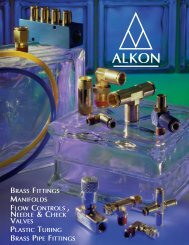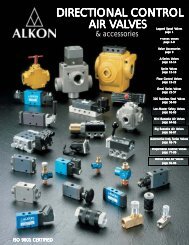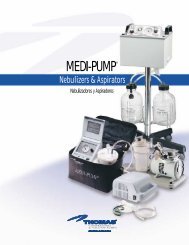Contents Norgren Pneumatic Valve Products
Contents Norgren Pneumatic Valve Products
Contents Norgren Pneumatic Valve Products
You also want an ePaper? Increase the reach of your titles
YUMPU automatically turns print PDFs into web optimized ePapers that Google loves.
Glossary<br />
Address – Part of the message sent by the Fieldbus Controller is concerned with<br />
the device address. Each address is unique, and specifies the location of each valve<br />
driver and the solenoid position for the valve.<br />
Analogue / Digital – Analogue signals are continuously variable (as is sound in the<br />
real world). Computers find it difficult to use analogue signals, so signals are<br />
converted into a digital form.<br />
ASIC – Application Specific Integrated Circuits. These are designed for electronic<br />
circuits for use within a specific Fieldbus system. i.e. an ASIC for one type of system<br />
cannot usually be used with another.<br />
Baud Rate – The speed at which digital information is transmitted. Baud rate is<br />
measured in bits/sec.<br />
Bi-directional – Refers to the fact that messages can be sent in both directions<br />
along the same wires.<br />
Binary – A mathematical system whereby the digits 0 and 1 are used to represent a<br />
character or piece of data in a computer. The electrical signals inside the computer<br />
can be thought of having only two states; signal off and signal on (0 and 1<br />
respectively).<br />
Bit/Byte/Word – A bit is a computing unit expressed as a choice of 0 or 1 (in basic<br />
terms - signal off or on). Bit actually stands for Binary Digit<br />
Byte – A group of eight bits. The lowest bit (rightmost)_ is equal to 0 or 1 and the<br />
highest bit is equal to 0 of 128. The highest value that one byte can represent is 255<br />
(or 256 states). i.e. 128 + 64 + 32 + 16 + 8 + 4 + 2 + 1 = 255<br />
Word – A group of sixteen bits. Words are used in 16 bit computers and many PLC<br />
data stores. A word can represent in binary form a maximum value of 65535 (or<br />
65536 states).<br />
Communication Bus – A physical link over which data is transmitted between<br />
suitable devices. The bus may be a wire, fiber optic, or radio wave.<br />
Diagnostics – A way of receiving information on faults or problems between<br />
devices. This is achieved by using visible indicators on or inside the Fieldbus unit or<br />
by communication between devices. i.e. if a program finds a fault, it may be<br />
instructed to reset the system or possibly to wait for further instruction from an<br />
operator.<br />
Fieldbus – Also bus. A data link (usually in the form of a cable) on which electrical<br />
devices communicate with each other for control purposes. In <strong>Pneumatic</strong> systems,<br />
Fieldbus linked drivers, operate valves or other remote devices. Feedback from<br />
sensors is provided by Input Modules.<br />
Hexadecimal – A mathematical system where each character can represent a value<br />
up to 15 (i.e. 16 states). i.e. Hex 0,1,2,3,4,5,6,7,8,9,A,B,C,D,E,F.<br />
I/O – Also Input/Output. The I/O is the physical connection between a controller and<br />
the equipment that it controls. The connected inputs may be switches, proximity<br />
devices or analogue sensors. Outputs may be relays, pneumatic solenoid coils or<br />
analogue devices. The Input module also serves as a barrier against harsh spikes<br />
and noise often experienced in an industrial environment. It may contain optoisolators<br />
which protect the CPU from large input surges.<br />
IP rating – Provides a means of classifying the degrees of protection from dust,<br />
water and impact afforded by electrical equipment enclosures. It is common practice<br />
for manufacturers to apply ratings for only the first two numerals.<br />
IP40 and IP65 – IP40 protects against solid objects over 1 mm (such as tools, wires,<br />
fingers), but has no protection against ingress of liquids. IP65 totally protects against<br />
dust and low pressure water jets from all directions.<br />
Ladder Logic – A method of describing an electrical circuit in logic symbols and<br />
relay-based ladder diagrams. It is the usual way to program PLC’s.<br />
Line Bus – A line bus does<br />
Master – A controller connected to a bus which issues messages to other devices<br />
on the same but. Masters contain programs to logically control processes and can<br />
be a PLC, PC or other control device.<br />
Supervisory Master – A controller which only concerns itself with the inputs and<br />
ignores all the outputs.<br />
PLC – Programmable Logic Controller<br />
Slave – A device connected to a bus which only responds when a message<br />
intended for itself is received. Except for a reply to that message, it can not access<br />
the bus. The common name for the valve driver or input module.<br />
Repeater – A device which can either boost the signal generated by a fieldbus<br />
master (in order that slaves can be positioned further from the signal source): or it<br />
may allow a greater number of devices to be connected to a Fieldbus system.<br />
<strong>Valve</strong> Manifold – Replaces the manifold solenoid valve bank. A combination of<br />
system valves, usually with a multipole, configured specifically to meet customers<br />
needs.<br />
Gateway – A converter which allows systems running two different protocols to<br />
communicate with each other: in effect a translator.<br />
Ladder logic – A method of describing an electrical circuit in logic symbols and<br />
relay-based ladder diagrams. It is the usual way to program PLC’s.<br />
Line bus – A line bus does not form a closed loop circuit.<br />
With the line bus networks <strong>Norgren</strong> promotes, all the<br />
stations are daisy chain together to overcome a problem<br />
associated with Spur distances. Although both a line-in and<br />
line-out are provided, they are effectively connected inside<br />
the Fieldbus units. However, DeviceNet units tap directly off<br />
the communication bus with t-pieces.<br />
Ring bus – Also Closed loop. All stations in a system are<br />
linked into a physical ring. With Interbus-S the link passes<br />
through each station in turn and each station is therefore an<br />
integral part of the transmission path. The data makes one<br />
trip around the ring, passed from station to station. Each<br />
station checks whether the data is addressed to it. When<br />
this is the case, the station copies the data into its own<br />
memory.<br />
Tree bus – Does not form a closed loop. Each station is<br />
linked to the transmission path by cables as required. Unlike<br />
Line bus, a Tree bus is more flexible because the<br />
communication can be laid out into any convenient shape.<br />
Multi-drop – Refers to a communications system which has<br />
two or more devices connected to it off a bus (i.e. more than<br />
one device can be connected to it).<br />
NEMA 4 – An American Standard for water penetration.<br />
Multipole – A connector in which all the individual wires for<br />
devices are combined in a cable which has en integral multipin<br />
connector for quick connection and installation in a<br />
system. i.e. a printer cable for connection to a computer<br />
employs a similar principle.<br />
Noise – Electrical interference, usually in the form of high<br />
voltage spikes or radio signals caused by unscreened or<br />
unsurpressed equipment. Noise can cause corruption of<br />
data during transmission or malfunction of electronic<br />
components.<br />
Open System – For a system to function properly, all<br />
devices must be compatible. With Open systems, the<br />
technology (or protocol) is available to allow manufacturers<br />
to build compatible equipment.<br />
Closed System – Also In-House or Proprietary system. A<br />
manufacturer develops the technology (or protocol) that is<br />
unique to him. Closed systems are therefore company<br />
specific and usually non-compatible with other types. Closed<br />
<strong>Norgren</strong> systems are: Pneubus, Sysmac, Jetterbus.<br />
Opto-isolator – Separates harsh industrial signals from<br />
sensitive components in a controller or slave. This is<br />
achieved by converting the signal to light. The external<br />
signal is transmitted as light to a light sensitive receiver.<br />
This in turn converts the light back into an electrical signal.<br />
Protocol – Defines the content and structure of a Fieldbus<br />
message. The differences between each Fieldbus protocol<br />
can be considered in the same way as those between<br />
languages.<br />
RS232, RS422, RS485 – American Standards for the<br />
electrical characteristics of a link. The standard specifies the<br />
digit state values. Links are used in the digital transmission<br />
of data between electronic equipment.<br />
RAM / ROM / EEPROM –<br />
RAM – Random Access Memory. RAM is used internally<br />
by a PC or PLC as a short term store for data, program<br />
variables and control codes. It is volatile and as such will<br />
lose all its data when power is removed. Therefore, RAM<br />
used for programs is battery backed.<br />
ROM – Read ONly Memory. ROM is pre-programmed by<br />
the manufacturer. It holds the controller system memory<br />
and instructions for its operation. It cannot be altered. It is<br />
non-volatile; when power is removed a ROM retains all its<br />
information.<br />
EEPROM – Electrically Erasable Programmable Read<br />
Only Memory. EEPROM’s are used to store the user<br />
program. They can be erased and programmed with<br />
relative ease. As with ROMS. EEPROM’s do not lose their<br />
contents when power is removed and as such they are<br />
non-volatile.<br />
Littleton, CO USA Phone: 303-794-2611 www.norgren.com VAL-2-41



